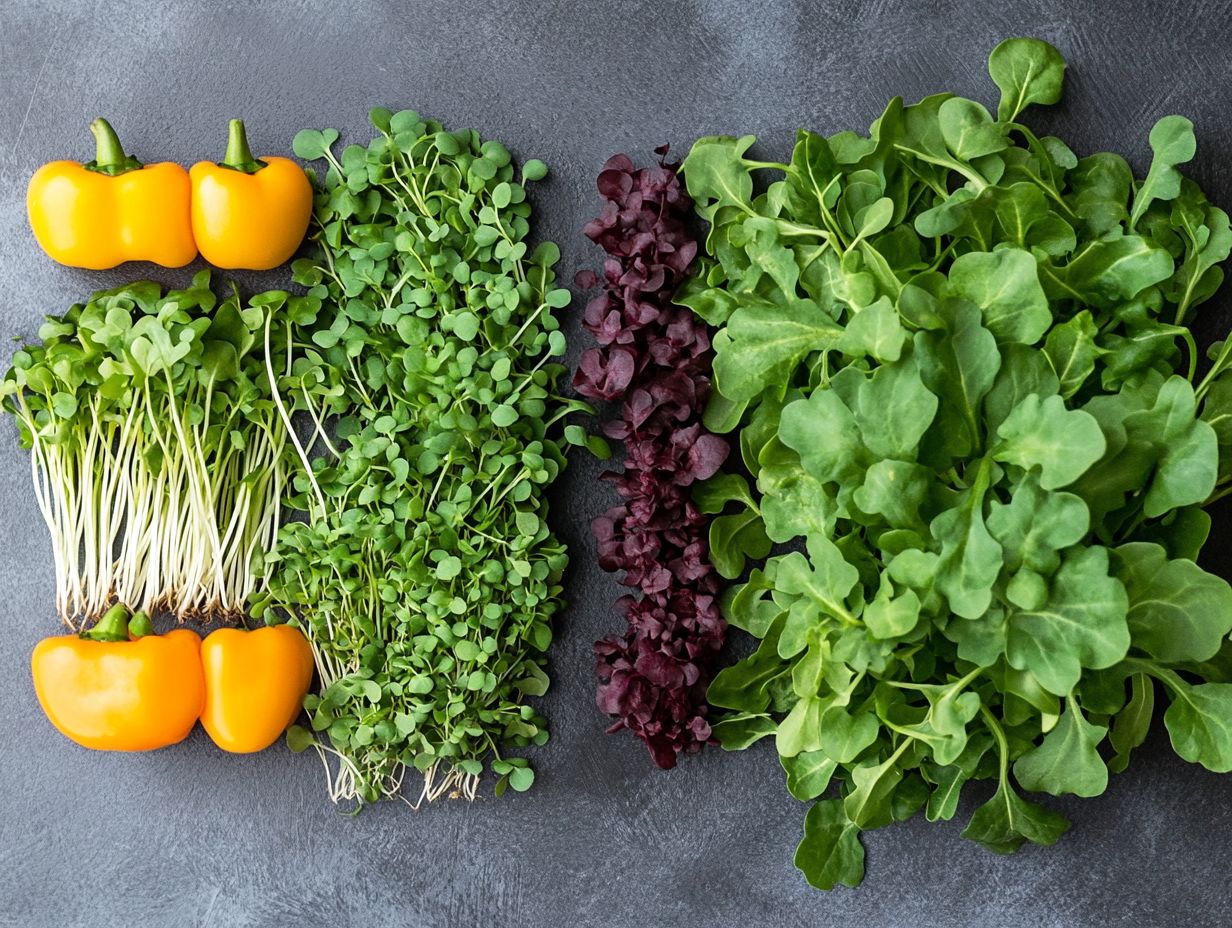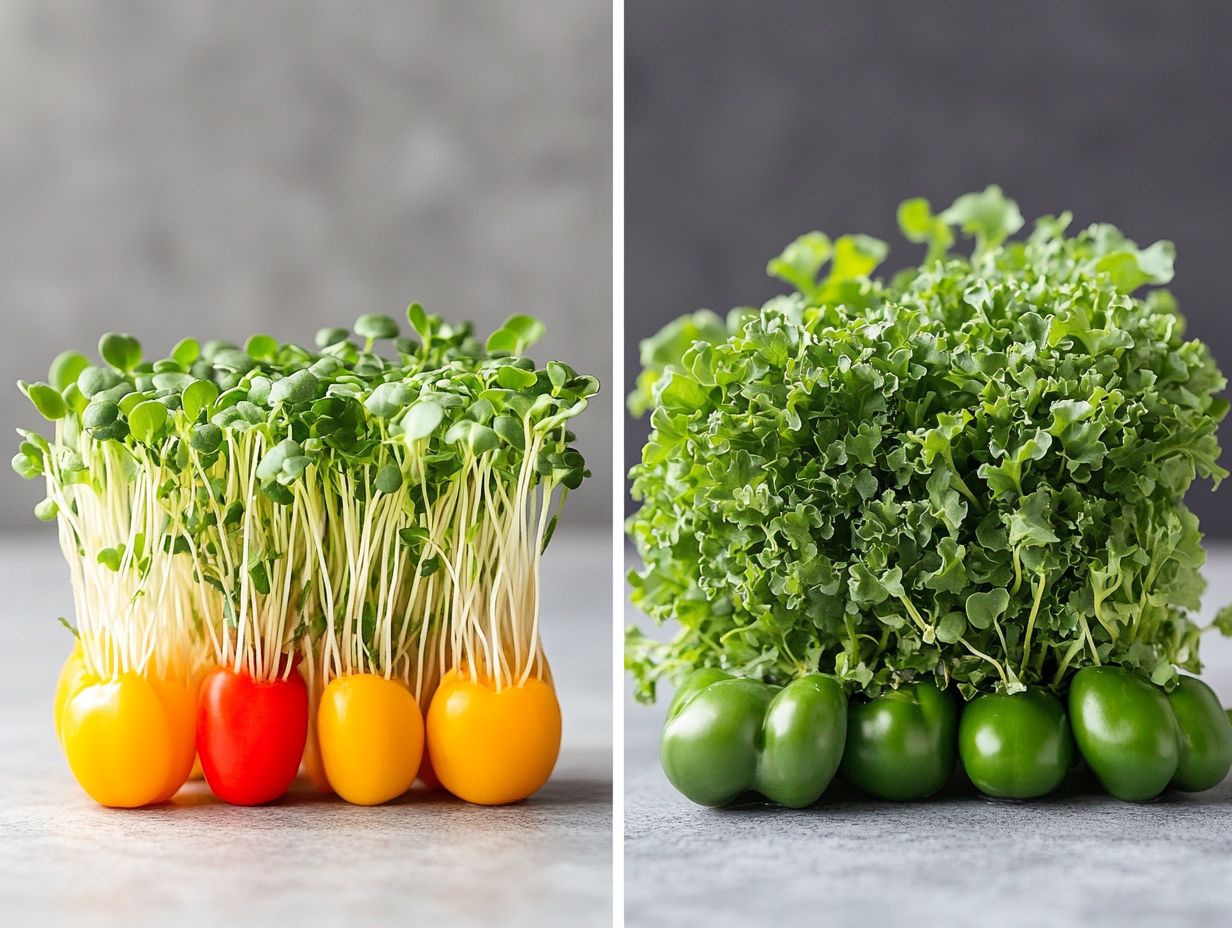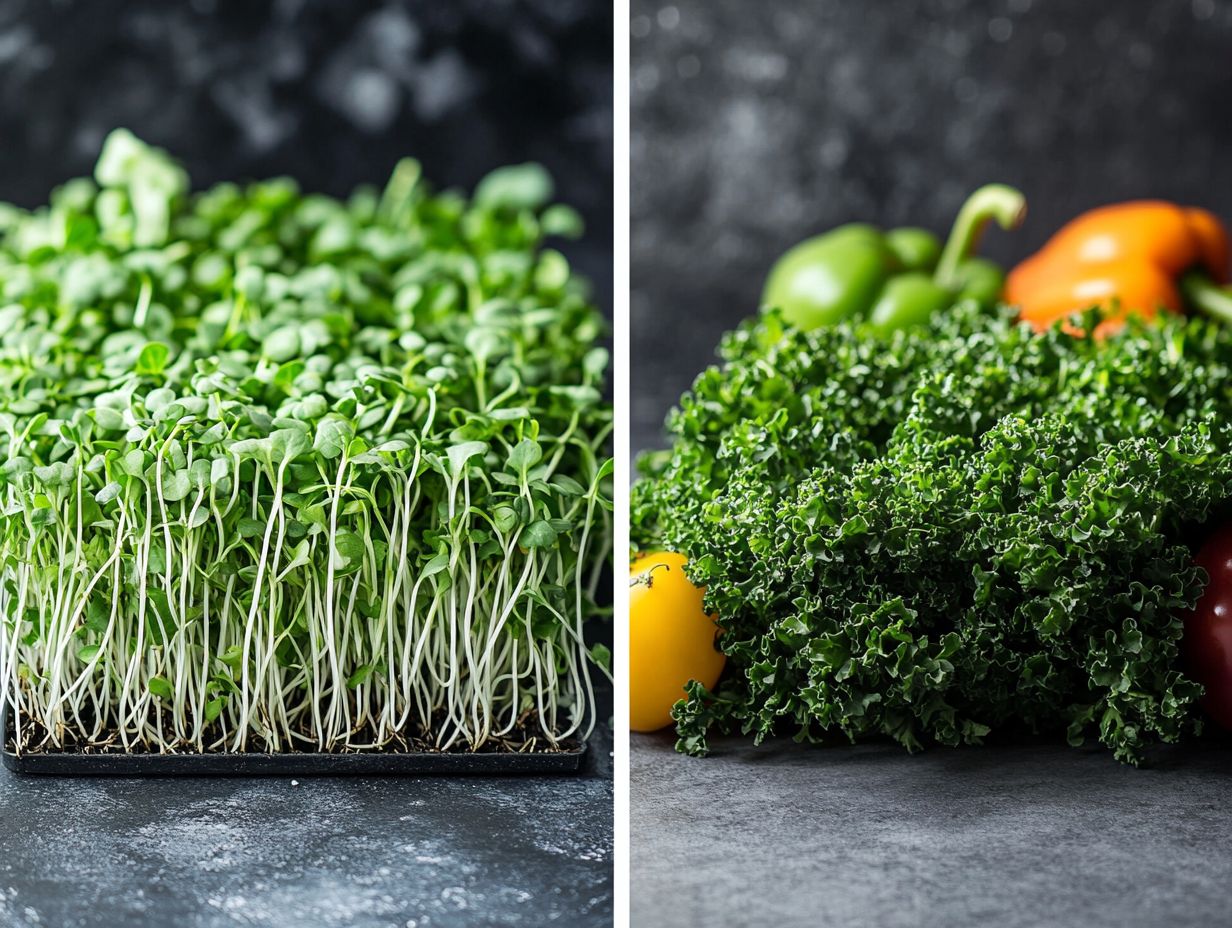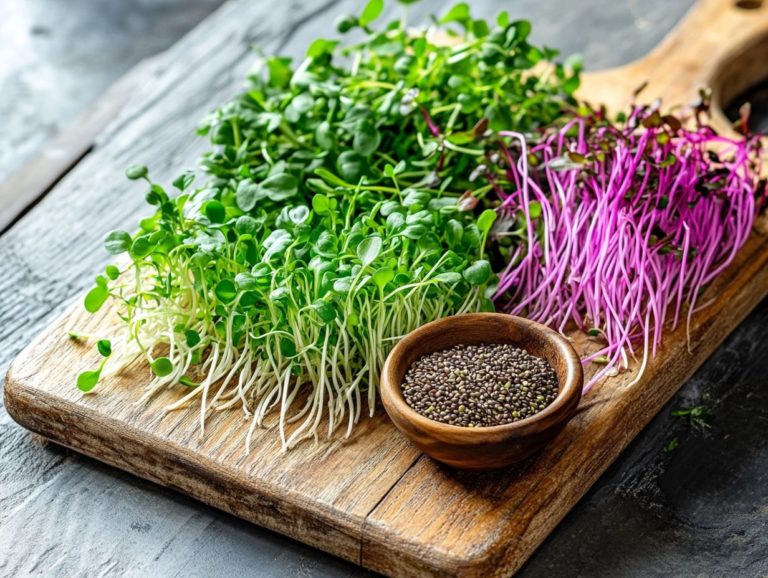Microgreens vs. Regular Vegetables: A Nutritional Comparison
Microgreens are small, vibrant seedlings bursting with flavor and nutrition. But how do they stack up against fully grown vegetables, especially regarding their nutritional profiles?
This article delves into the nutritional differences between microgreens and regular vegetables, highlighting their vitamin, mineral, and antioxidant content, as well as their health benefits. Get ready to discover the amazing health benefits of microgreens and find creative ways to incorporate them into your meals!
This article also looks at cost and availability to help you choose between these nutritious options. Prepare to uncover the advantages and ideal uses for both!
Contents
- Key Takeaways:
- Nutritional Differences Between Microgreens and Regular Vegetables
- Why Microgreens Are Your New Superfood for Vitamins and Minerals!
- Comparison of Antioxidant Levels
- Comparison of Nutrient Density
- Health Benefits of Microgreens
- How to Incorporate Microgreens into Your Diet
- Considerations When Choosing Between Microgreens and Regular Vegetables
- Frequently Asked Questions
- What are microgreens?
- What is the nutritional difference between microgreens and regular vegetables?
- Are microgreens more nutrient-dense than regular vegetables?
- Do microgreens provide a wider range of nutrients compared to regular vegetables?
- Can I replace regular vegetables with microgreens in my diet?
- Are there any specific health benefits of choosing microgreens over regular vegetables?
Key Takeaways:

- Microgreens contain higher levels of vitamins and minerals compared to regular vegetables, making them a more nutrient-dense option for your diet.
- Incorporating microgreens into your meals can provide health benefits such as improved digestion, enhanced gut bacteria, a boosted immune system, and reduced inflammation.
- Consider your budget, availability, and personal preferences when choosing between microgreens and regular vegetables, as both offer unique nutritional benefits.
Understanding Microgreens vs. Regular Vegetables
Microgreens are young, edible plants you encounter just after they sprout their first true leaves. They deliver an explosion of flavor and a treasure trove of concentrated nutrients.
In contrast, regular vegetables are the fully matured versions, showcasing a wider array of flavors and textures. Research by Thomas T. Y. Wang at the Agricultural Research Service of the U.S. Department of Agriculture and the University of Maryland highlights that microgreens serve as a strong alternative to traditional vegetables, thanks to their superior nutritional profiles and potential health benefits, particularly in the context of chronic diseases. The nutritional benefits of common microgreens are why they’ve become a favorite among health-conscious individuals.
These petite greens are typically harvested just a week or two after germination, flaunting vibrant flavors and packing a punch of vitamins and antioxidants. They can boast up to five times the nutritional content of their fully grown counterparts. Regular vegetables, on the other hand, often take months to cultivate, showcasing popular options like cruciferous vegetables such as broccoli and kale. For more on their benefits, check out microgreens: nature’s vitamins in a tiny package.
While mature vegetables offer essential nutrients like fiber and minerals, microgreens stand out by providing concentrated doses of vitamins A, C, E, and K, along with beneficial compounds. This remarkable nutrient density makes microgreens an enticing option for anyone eager to amplify their health benefits. In fact, they are considered a solution for nutrient deficiency without sacrificing taste.
Nutritional Differences Between Microgreens and Regular Vegetables
Grasping the nutritional distinctions between microgreens and regular vegetables is vital for enhancing your dietary intake and addressing specific dietary needs.
Though diminutive in size, microgreens often contain a higher concentration of vitamins and minerals. This remarkable attribute is why they are increasingly recognized by health science professionals as potent health boosters.
Start your journey to a healthier diet today by adding microgreens to your next dish!
Why Microgreens Are Your New Superfood for Vitamins and Minerals!
When comparing vitamins and minerals, microgreens pack a powerful punch. They boast higher levels of essential nutrients like vitamin C, vitamin E, and vitamin K than mature vegetables. This makes them an impressive ally for meeting your daily dietary needs.
The remarkable concentration of these nutrients can significantly boost your immunity, promote skin health, and enhance bone density. In fact, research shows that certain antioxidants in microgreens can be up to 40 times more concentrated than in fully grown counterparts, highlighting their nutritional superiority.
You will also discover crucial minerals, such as potassium and magnesium, vital for maintaining heart function and muscle health. By incorporating microgreens into your diet, you can effortlessly elevate your nutrient intake while supporting overall wellness in a delicious and versatile way.
Comparison of Antioxidant Levels

Recent studies reveal that microgreens boast significantly higher antioxidant levels than standard vegetables. They are packed with concentrated amounts of bioactive compounds like polyphenols and flavonoids, which play a key role in their celebrated health benefits.
Powerful antioxidants neutralize harmful free radicals in your body, potentially reducing the risk of chronic diseases such as heart disease and cancer. This makes their inclusion in a balanced diet even more beneficial. In fact, studies show that microgreens can pack a punch with up to 40 times more antioxidants than their fully grown counterparts, with varieties like broccoli and radish microgreens standing out for their impressive ability to combat oxidative stress. Furthermore, the influence of microgreens on overall nutrition highlights their significant health benefits.
Incorporating these nutrient-dense greens into your diet can enhance detoxification, improve cardiovascular health, and promote overall well-being. This aligns with current food trends centered around health science, making them an invaluable addition to any balanced meal plan.
The vast implications of adding antioxidant-rich foods to your diet highlight just how crucial nutrition is in disease prevention. Don’t miss out on these nutrient-dense greens!
Comparison of Nutrient Density
Nutrient density plays an important role in assessing the health benefits of food. Microgreens often outshine regular vegetables in this aspect due to their high levels of plant nutrients. They provide a concentrated source of dietary fiber and essential nutrients in smaller servings.
This impressive nutrient density means that just a small handful of microgreens can offer significant amounts of vitamins A, C, E, and K, along with various antioxidants, including carotenoids. For a detailed look at their benefits, check out the nutrient comparison of popular microgreen varieties, elements crucial for maintaining optimal health.
For instance, a study published in the *Journal of Agricultural and Food Chemistry* revealed that certain microgreens can contain up to 40 times more nutrients than their mature counterparts. Such findings highlight their potential benefits for specific health conditions like cardiovascular health and inflammation reduction, making them an enticing option for those who want to elevate their diet without gaining weight. To learn more about the best microgreens for nutritional value, consider incorporating them into your meals.
Health Benefits of Microgreens
Microgreens are renowned for their remarkable health benefits, making them an excellent choice for anyone aiming to enhance their diet and support gut health. They’ve been associated with:
- Cancer prevention
- Inflammation reduction
- Management of chronic diseases
These health benefits resonate with the latest food trends centered around health science and nutritional wellness, emphasizing the biological effects of their phytochemicals.
Specific Health Benefits
Microgreens offer many health benefits, especially for your gut. They improve gut bacteria, help manage weight, and are packed with antioxidants.
For example, studies reveal that microgreens are brimming with vitamins and minerals that actively support good bacteria, enhancing the overall microbiome. This, in turn, enhances your digestion and nutrient absorption.
Their low-calorie count combined with a generous fiber content makes them an exceptional addition to any weight management regimen. You can enjoy these greens knowing they help you feel satisfied longer without piling on extra calories.
The antioxidants in microgreens are crucial for fighting chronic diseases, often worsened by a high-fat diet. They work to reduce inflammation and oxidative stress in your body, two culprits often linked to the development of serious health issues such as heart disease and diabetes. Embracing microgreens could be a game-changer for your overall health, especially for those conscious of their dietary needs. Exploring the nutritional advantages of microgreens for kids can further enhance their benefits.
How to Incorporate Microgreens into Your Diet

Growing microgreens at home is a fun and rewarding experience! You can easily cultivate them at home or seamlessly integrate them into a variety of dishes, enhancing the culinary uses of fresh produce in your meals.
They elevate flavor profiles while significantly enhancing your nutritional intake, making them a versatile and valuable addition to your culinary repertoire, appealing to both home cooks and culinary professionals.
Recipe Ideas and Tips
Try adding microgreens to a variety of dishes, from salads to s smoothies and grain bowls, where their refreshing crunch adds to the dish’s flavor profiles. They offer a burst of flavor and nutrients that elevate fresh produce to new heights.
These tiny, vibrant greens not only enhance the visual appeal of your meals but also deliver impressive health benefits, such as cancer prevention. Rich in vitamins, minerals, and antioxidants, microgreens: tiny greens, big benefits are an excellent choice for anyone looking to boost their nutrient intake.
Imagine incorporating them into grain bowls, where their refreshing crunch contrasts beautifully with creamy avocado or hearty roasted vegetables, while adding valuable dietary fiber. A sprinkle of these greens on omelets or sandwiches can transform ordinary dishes into extraordinary culinary experiences, making them a true health booster and providing a natural source of nutrients.
With endless possibilities, it’s clear why microgreens have become a favorite ingredient among home cooks and chefs alike, contributing to the growing trends in culinary health science.
Considerations When Choosing Between Microgreens and Regular Vegetables
When deciding between microgreens and regular vegetables, think about cost, availability, and your preferences. These factors shape your diet and nutrition.
Each of these elements ultimately influences your dietary variety and nutritional intake, helping you craft a balanced and enjoyable menu.
Cost, Availability, and Personal Preferences
Cost and availability are essential factors to consider when deciding between microgreens and regular vegetables. You might find microgreens pricier or harder to come by. They bring impressive health benefits and versatile culinary uses.
This financial aspect often plays a significant role in your decision-making. You weigh the potential health benefits against your budget. The seasonal availability of local produce can impact your choice. Many opt for the more straightforward option of regular vegetables that are readily accessible.
Your personal preferences, including flavor profiles and specific dietary needs, will further guide your selections. In the kitchen, both microgreens and regular vegetables offer remarkable versatility. Microgreens can transform your meals with their vibrant colors and rich flavors, while regular vegetables serve as the plant-based cornerstone of many meals.
Frequently Asked Questions

What are microgreens?
Microgreens are small, edible plants harvested at an early stage of growth. They are smaller than baby greens and larger than sprouts, known for their intense flavor and high nutritional value.
What is the nutritional difference between microgreens and regular vegetables?
Microgreens are known to contain up to 40 times more nutrients than fully grown vegetables. They are harvested when their nutrient content is at its peak.
Are microgreens more nutrient-dense than regular vegetables?
Yes, studies have shown that microgreens are full of nutrients compared to fully grown vegetables. Their concentrated nutrient content comes from being harvested at an early stage of growth.
Do microgreens provide a wider range of nutrients compared to regular vegetables?
Yes, microgreens offer a wider range of nutrients. Different types of microgreens have unique nutrient profiles, making them a diverse and nutritious addition to any diet.
Can I replace regular vegetables with microgreens in my diet?
While microgreens are a great addition to any diet, they should not be solely relied on for all your nutritional needs. It is important to have a well-balanced diet that includes various fruits, vegetables, and other nutrient-rich foods.
Are there any specific health benefits of choosing microgreens over regular vegetables?
Yes, consuming microgreens has been associated with improved digestion, a stronger immune system, and reduced risk of chronic diseases. This is due to their high nutrient content and antioxidant properties.






